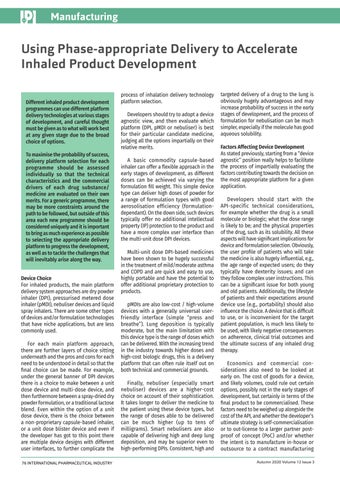Manufacturing
Using Phase-appropriate Delivery to Accelerate Inhaled Product Development Different inhaled product development programmes can use different platform delivery technologies at various stages of development, and careful thought must be given as to what will work best at any given stage due to the broad choice of options. To maximise the probability of success, delivery platform selection for each programme should be assessed individually so that the technical characteristics and the commercial drivers of each drug substance/ medicine are evaluated on their own merits. For a generic programme, there may be more constraints around the path to be followed, but outside of this area each new programme should be considered uniquely and it is important to bring as much experience as possible to selecting the appropriate delivery platform to progress the development, as well as to tackle the challenges that will inevitably arise along the way. Device Choice For inhaled products, the main platform delivery system approaches are dry powder inhaler (DPI), pressurised metered dose inhaler (pMDI), nebuliser devices and liquid spray inhalers. There are some other types of devices and/or formulation technologies that have niche applications, but are less commonly used. For each main platform approach, there are further layers of choice sitting underneath and the pros and cons for each need to be understood in detail so that the final choice can be made. For example, under the general banner of DPI devices there is a choice to make between a unit dose device and multi-dose device, and then furthermore between a spray-dried dry powder formulation, or a traditional lactose blend. Even within the option of a unit dose device, there is the choice between a non-proprietary capsule-based inhaler, or a unit dose blister device and even if the developer has got to this point there are multiple device designs with different user interfaces, to further complicate the 76 INTERNATIONAL PHARMACEUTICAL INDUSTRY
process of inhalation delivery technology platform selection. Developers should try to adopt a device agnostic view, and then evaluate which platform (DPI, pMDI or nebuliser) is best for their particular candidate medicine, judging all the options impartially on their relative merits. A basic commodity capsule-based inhaler can offer a flexible approach in the early stages of development, as different doses can be achieved via varying the formulation fill weight. This simple device type can deliver high doses of powder for a range of formulation types with good aerosolisation efficiency (formulationdependant). On the down side, such devices typically offer no additional intellectual property (IP) protection to the product and have a more complex user interface than the multi-unit dose DPI devices. Multi-unit dose DPI-based medicines have been shown to be hugely successful in the treatment of mild/moderate asthma and COPD and are quick and easy to use, highly portable and have the potential to offer additional proprietary protection to products. pMDIs are also low-cost / high-volume devices with a generally universal userfriendly interface (simple “press and breathe”). Lung deposition is typically moderate, but the main limitation with this device type is the range of doses which can be delivered. With the increasing trend in the industry towards higher doses and high-cost biologic drugs, this is a delivery platform that can often rule itself out on both technical and commercial grounds. Finally, nebuliser (especially smart nebuliser) devices are a higher-cost choice on account of their sophistication. It takes longer to deliver the medicine to the patient using these device types, but the range of doses able to be delivered can be much higher (up to tens of milligrams). Smart nebulisers are also capable of delivering high and deep lung deposition, and may be superior even to high-performing DPIs. Consistent, high and
targeted delivery of a drug to the lung is obviously hugely advantageous and may increase probability of success in the early stages of development, and the process of formulation for nebulisation can be much simpler, especially if the molecule has good aqueous solubility. Factors Affecting Device Development As stated previously, starting from a “device agnostic” position really helps to facilitate the process of impartially evaluating the factors contributing towards the decision on the most appropriate platform for a given application. Developers should start with the API-specific technical considerations, for example whether the drug is a small molecule or biologic; what the dose range is likely to be; and the physical properties of the drug, such as its solubility. All these aspects will have significant implications for device and formulation selection. Obviously, the user profile of patients who will take the medicine is also hugely influential, e.g., the age range of expected users; do they typically have dexterity issues; and can they follow complex user instructions. This can be a significant issue for both young and old patients. Additionally, the lifestyle of patients and their expectations around device use (e.g., portability) should also influence the choice. A device that is difficult to use, or is inconvenient for the target patient population, is much less likely to be used, with likely negative consequences on adherence, clinical trial outcomes and the ultimate success of any inhaled drug therapy. Economics and commercial considerations also need to be looked at early on. The cost of goods for a device, and likely volumes, could rule out certain options, possibly not in the early stages of development, but certainly in terms of the final product to be commercialised. These factors need to be weighed up alongside the cost of the API, and whether the developer’s ultimate strategy is self-commercialisation or to out-license to a larger partner postproof of concept (PoC) and/or whether the intent is to manufacture in-house or outsource to a contract manufacturing Autumn 2020 Volume 12 Issue 3





















